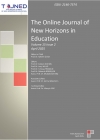TOJNED - Volume 5 - Issue 4 - October 2015
 DETERMINING THE FACTORS CAUSING THE PRISONERS IN PRISON FOR CRIME AND PSYCHO-SOCIAL SERVICES (T.R.N.C SAMPLE)
DETERMINING THE FACTORS CAUSING THE PRISONERS IN PRISON FOR CRIME AND PSYCHO-SOCIAL SERVICES (T.R.N.C SAMPLE) PhD Candidate Demet KARAKARTAL, Prof. Dr. Münevver Yalçınkaya
Abstract: The general aim of this study is to identify the factors causing prisoners to crime and determine the psycho-social support services in prisons, to fulfil the knowledge gap about topic and to contribute to the field area within the frame of theory and application. By using quantitative data gathering technique, in this study the data was obtained by open ended, semi-structured questions, and a personal information forms which are developed by the researcher. The study group of the research includes; a social services expert and 50 sentenced prisoner in Nicosia Central Prison in 2014-2015 who are determined by convenience method. According to data; it was observed that the socio-demographic conditions of prisoners and their previous experiences before the prison are the effective factors to turn into crime. It has been observed that; the social service needs for the prisoners when they firstly sentenced to the prison, or during their stay there, during pre-evacuation and post-evacuation period can be changed.
 Effect of Positive Behavioral Interventions and Supports on School Wide Discipline in a Title I Intermediate School
Effect of Positive Behavioral Interventions and Supports on School Wide Discipline in a Title I Intermediate School Joshua P. Spencer, Ed.D.
Abstract: The implementation of positive behavioral interventions and supports (PBIS) has become a priority to school districts and departments of education due to the Individuals with Disabilities Education Improvement Act of 2004, which requires the development and implementation of behavior intervention plans. At a Title I school in South Carolina, a PBIS was implemented after students were increasingly being removed from the classroom due to disruptive behavior. This quantitative program evaluation examined the effect of PBIS on office referrals. The theoretical framework associated with PBIS involves transformational theory, which includes actions that empower, inspire, and encourage others to show their potential. The research question explored the effect of PBIS on reducing the number of students sent to the office with a referral by teachers, and the quasi-experimental design was pretest-posttest with no control group. A paired t test was used to examine differences in the number of students sent to the office before and after PBIS implementation, and the sample size studied was 412 students. After PBIS implementation, there were significant decreases in the number of office referrals for each offense category. This study also provides teachers with information to help students exhibit desirable behaviors and decrease disruptive ones.
 ENVIRONMENTAL LITERACY IN 9th GRADE STUDENTS FROM MADEIRA ISLAND (PORTUGAL)
ENVIRONMENTAL LITERACY IN 9th GRADE STUDENTS FROM MADEIRA ISLAND (PORTUGAL) Hélder SpÃÂnola
Abstract: Has a contribution to evaluate present levels of environmental literacy in Madeira Island (Portugal), we developed a survey involving 491 9th grade students and found a good level of knowledge (71.8%), a strong tendency to agree with the New Ecological Paradigm (58.2%) and an encouraging level of environmentally responsible behaviors (47.9%) in a ‘very often’ and ‘always’ basis. Results from present study should be considered to improve environmental education programs in place, especially in Portugal and Madeira Island, but new surveys were needed to evaluate other age groups as also the relationship between different components of environmental literacy.
 INTERNATIONALIZATION: AS AN IMPORTANT FACTOR ON UNIVERSITYINDUSTRY COLLABORATION
INTERNATIONALIZATION: AS AN IMPORTANT FACTOR ON UNIVERSITYINDUSTRY COLLABORATION Gökçe MEREY, Reha Metin ALKAN
Abstract: Financial, social, political and cultural developments changed agricultural society into an industrial society. With the advent of new technologies, the world has turned into an information society. Due to the improvements in technology and mass media, social changes and international interactions have gained speed. Therefore, globalization has become inevitable and has given way to transition from information society to communication society by creating a world beyond borders. In this study, the effects of globalization and internationalization are examined from educational, cultural, financial and industrial aspects.
 INTRODUCTORY STUDY ON STUDENT’S MENTAL MODELS IN UNDERSTANDING THE CONCEPT OF ATOMIC STRUCTURE (Case Study on High School Students in Lampung Indonesia)
INTRODUCTORY STUDY ON STUDENT’S MENTAL MODELS IN UNDERSTANDING THE CONCEPT OF ATOMIC STRUCTURE (Case Study on High School Students in Lampung Indonesia) Sunyono, Dwi Yulianti
Abstract: Several researchas indicated that mental models can affect the students' ability to perform reasoning on external representations encountered. Students' mental models are generally used to thinking in problem solving. Objective of this research is to look at the characteristics of initial mental models of students in understand the concept of atomic structure. Research subjects taken from students of high schools in Lampung Indonesia that have been selected as the sample. The number of samples involved as many as 119 people consisting of students of class XI. Diagnostic tests in the form of an essay used to see the emergence of a mental model of atomic structure that is tested in Class XI. The results of the research show that for all groups of students' early knowledge, initial mental models of the students in understanding the concept of atomic structure is dominated by verbal mental model of the category "very bad" and "bad," or the characteristics of "unformed" and "intermediate 1" mental models. This finding implies that students' mental models can be used as a reference in determining the instruction strategies that can help students in problems solving related to the phenomenon sub-microscopic, macroscopic, and symbolic.
 INVESTIGATING THE USE OF COLLABORATIVE TOOL IN AN ADULT LEARNING ENVIRONMENT
INVESTIGATING THE USE OF COLLABORATIVE TOOL IN AN ADULT LEARNING ENVIRONMENT Siti Hajar Halili, Rafiza Abdul Razak, Zamzami Zainuddin
Abstract: This study was carried out in order to investigate the Knowles (1980) adult learning principles preferred by adult learners using collaborative tool in teaching and learning process. The theoretical foundation for this study is the andragogy theory by Knowles (1980) that holds a set of adult learning principles such as learners’ self-concept; motivation to learn, readiness to learn, role of learners’ experience, learners’ need to know and learning orientation. Five adult learners from the postgraduate program in University of Malaya were selected and interviewed. Data were collected and coded to summarize the main themes. The study findings show that in identifying the principles of adult learning introduced by Knowles (1980) with the use of Wiggio, the opinion of all respondents are positive toward application of collaboration tools in line with the adult learning principles. This means usage of Wiggio is suited to the principles of adult learning introduced by Knowles (1980). The findings have implications for educators especially for those involved in adult education field as they need to consider adult learners preferences when planning teaching and learning activities with the usage of technology.
 IS WILLIAMS SYNDROME THE ‘CONVERSE’ OF AUTISM SPECTRUM DISORDER?
IS WILLIAMS SYNDROME THE ‘CONVERSE’ OF AUTISM SPECTRUM DISORDER? Nor Siti Rokiah binti Abdul Razak
Abstract: Williams Syndrome (WMS) and Autism Spectrum Disorder (ASD) are neuro-developmental disorders associated with distinct social phenotypes. Infant and young children associated with these two disorders provided evidence of developmental delay. This paper attempts on analyzing the extent of convergence and divergence of the behaviours in WMS and the symptoms of ASD. Features of diagnosis and characteristics, as well as developmental achievements in these two disorders will also be addressed further. Moreover, in depth discussion and comparison on a number of aspects including; intellectual ability, visual-spatial skills, language and communication, social interaction and emotion detection, in regards to both disorders will be dealt in detail throughout the rest of this paper.
 POSITION OF A PUPIL AND A STUDENT IN THE PROCESS OF VALUE ORIENTATION FORMATION
POSITION OF A PUPIL AND A STUDENT IN THE PROCESS OF VALUE ORIENTATION FORMATION Ján Danek, Eva Frýdková
Abstract: Value orientation of children and adolescents is a significant phenomenon of upbringing as well as of the target of an educational activity. This article focuses on the position of a pupil and a student in the process of value orientation formation in a school environment. It points out certain practical activities aimed at the development of social habits and at forming of a pupil´s character which can be applied during an educational process or outside of it.
 RELATIONSHIP BETWEEN NEGATIVE COGNITIVE STYLE AND DEPRESSION AMONG UNIVERSITY STUDENTS
RELATIONSHIP BETWEEN NEGATIVE COGNITIVE STYLE AND DEPRESSION AMONG UNIVERSITY STUDENTS Shagufta Perveen
Abstract: Several studies have documented the link between negative cognitive style and depression. However, little is known about the mechanisms underpinning the relationship between negative cognitive style and depression. Using battery of scales naming Quick Inventory of Depressive Symptomatology – Self Report (QIDS-SR; Rush et al., 2003) Cognitive style Questionnaire (CSQ-SF; Meins, et al., 2012)and Center for Epidemiologic Studies Depression Scale (CES-D; Radloff, 1977) study explored the relationship between cognitive styles and depression in a non clinical sample of 1000 Pakistani university students. The study result show positive relationship between negative cognitive style and depression among students. Exploring the gender differences results indicates that men have higher scores on self worth, stability and while women have high scores on Internality based cognitive styles.. Result also shows that the mean score of women is higher on Somatic Complaints, Depressed Affect and Interpersonal Problem. Whereas men scored higher on positive affect.


